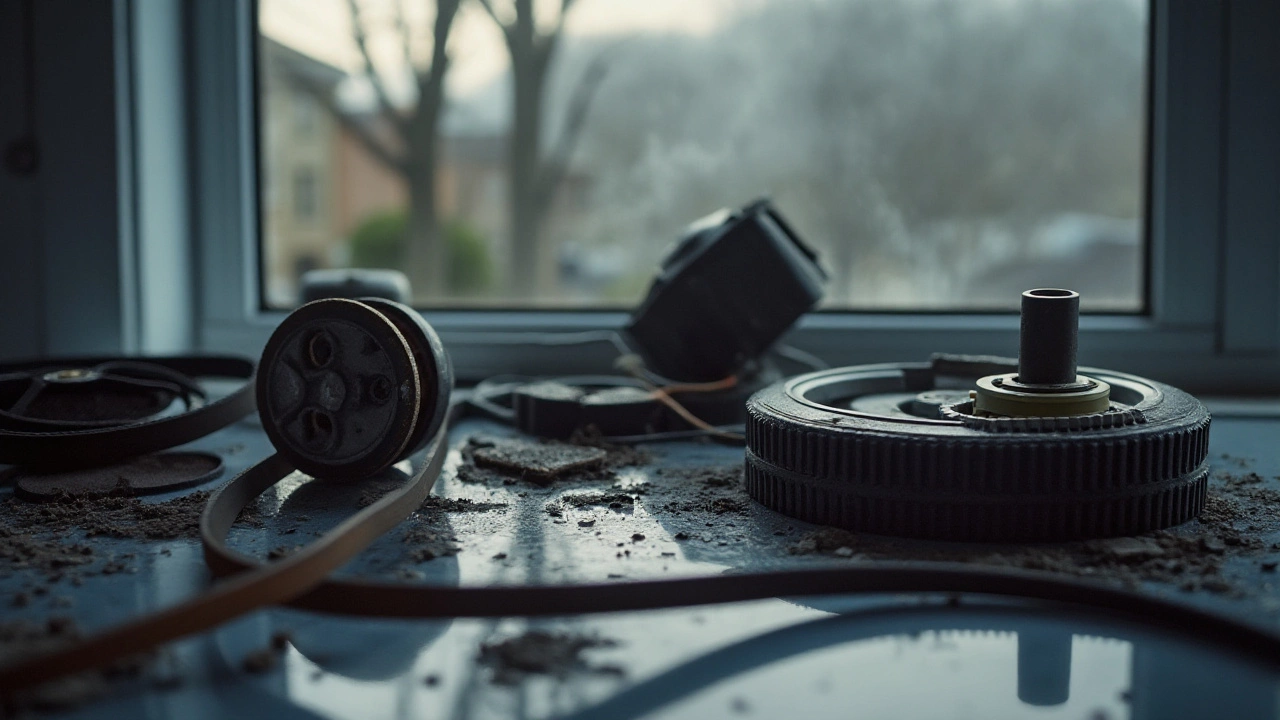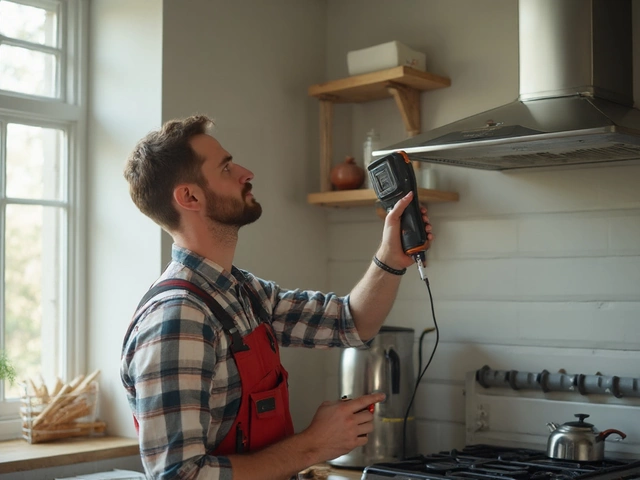Having trouble with your tumble dryer not spinning? It's a common issue, and it often happens at the worst possible time. But before you start considering a new purchase, let's delve into what might be causing the problem and how you can possibly fix it.
Your dryer not spinning can arise from various causes. While some problems might need professional attention, others might be sorted out with a little patience and some handy work. Let's explore the possible reasons and get your dryer back to working order.
- Common Mechanical Issues
- How to Check the Drive Belt
- Inspecting the Motor and Bearings
- Role of the Door Switch
- Signs of Wear and Tear
- When to Call a Professional
Common Mechanical Issues
When your tumble dryer refuses to spin, the cause often lies in the heart of its mechanical systems. Identifying these issues can save both time and frustration. The complexity of the components might seem daunting, but understanding a few key areas could provide just the insight you need to address the problem effectively.
One of the usual suspects is the drive belt – that trusty component responsible for turning the drum. Over time, the belt can become loose or even break, causing the drum to stop spinning altogether. To assess this, you'll need to gain access to the back of the dryer, where the belt can be visually inspected for signs of wear or damage. If it's snapped or hanging loose, a replacement is necessary, which may seem daunting but with a little guidance, it’s a manageable DIY task.
Another vital player in the spinning game is the motor. Motors sometimes become strained due to continuous use and can eventually fail, leading to your dryer sitting still. If the motor is running but the drum isn’t turning, it might emit a humming sound, indicating that it hasn't given up entirely but is struggling. In some cases, replacing or even repairing the motor is inevitable, an endeavor that could require professional assistance if you're not mechanical-savvy yourself. This involvement ensures the maintenance of energy efficiency and extends the life of the appliance itself.
Bearings and pulleys are also integral to the dryer’s operation. If they wear out, the drum may not spin effectively, or at all. Signs of this issue might include unusual noises such as squeaks or grinding, which could signal that these parts need lubrication or replacement. Regular maintenance checks can prevent such surprises, ensuring that the dryer remains functional and effective over the years.
Other Influential Factors
Sometimes overlooked, the idler pulley plays a significant role in maintaining tension on the belt. If this component has worn out, the belt can slip, halting the drum’s motion. Inspecting the pulley's condition might reveal whether it needs replacing. Accessories such as the tension spring linked to the pulley are also worth examining, as their effectiveness can diminish over time.
The dryer’s drum itself can be problematic. If it's placed unevenly, the machine can encounter imbalance issues, seriously affecting its spinning capacities. Placing lighter loads in an unbalanced manner might not only halt rotations but also pose a risk to the drum's shape and function. Even lint build-up can weigh heavily upon the drum's movement, hinting at the importance of cleaning routines that protect both the dryer and your clothes.
These components quietly work together to ensure that laundry days go smoothly. Balancing mechanical insight with cautious investigations can often bring a satisfying solution, turning frustration into productivity. As we dive deeper into solutions, remember that maintenance is key and when in doubt, don't hesitate to consult experts. After all, knowing when to react is just as important as understanding what to do when the dryer takes a pause.
How to Check the Drive Belt
When your trusty tumble dryer refuses to spin, one of the first things you should check is the drive belt. This humble component has the critical job of turning the dryer drum. To begin this inspection, remember that safety comes first. Make sure to unplug the dryer from the power source. This not only prevents any electrical accidents but also preserves the components from unexpected surges. Once you're sure the dryer is safely disconnected, prepare a clean workspace where you can lay out the parts and screws you might need to handle.
You'll need to access the back panel of your dryer, which means, in most cases, moving the appliance away from the wall. Use a screwdriver to remove the back panel cautiously. As you do this, pay attention to the screws to avoid losing any. Once you’ve removed the panel, you should see the drive belt wrapped around both the drum and the motor pulley. Check its tension, as a loose or broken belt might be the culprit stopping your dryer from spinning. Run your fingers along the belt's surface to feel for cracks, tears, or signs of fraying. If the belt seems worn out, it might be time to replace it with a new one.
Before you rush out to get a replacement, take a moment to grasp the belt's route around the drum and motor. Take a picture if you need to, as it will serve as a useful reference when it comes to fitting the new belt. Replacing the belt is quite straightforward once you know the path it should take. Simply remove the worn belt by pulling it off the motor pulley, and slide the new belt over in the same configuration. Make sure it's sitting snugly and properly aligned, as this will ensure efficient spinning once everything is reassembled. While you're here, it might also be helpful to glance at the pulley and the motor shaft, checking for any debris or wear.
According to appliance expert Robert Miller, "A dryer’s drive belt should be examined for tension and surface quality during regular maintenance. Neglecting this small component can lead to bigger problems down the line."
Once the new belt is in place, reattach the back panel securely and plug your dryer back into the outlet. Remember to test run it with a smaller load first to ensure that the drum spins smoothly and there’s no unusual noise. This step not only confirms the belt's effectiveness but also calibrates the mechanics energetically after the reassembly. If your dryer is now rotating without any hitches, congratulations—you’ve successfully diagnosed and solved one of the most common mechanical issues. However, if the drum still isn't spinning correctly, it might be wise to delve deeper into other potential problem areas mentioned in the subsequent sections or consider calling in an appliance expert for a more thorough assessment.

Inspecting the Motor and Bearings
The heartbeat of any tumble dryer lies within its motor and bearings, and when these elements malfunction, your machine might refuse to spin. Start by unplugging the dryer and laying it on its back or side to access the motor housing. A visual inspection often reveals if something seems off. Look for any visible damage or signs of overheating, like a burnt smell or discolored wiring. Motors are prone to collecting lint and debris, which might cause them to seize or perform poorly. Use a vacuum or a dry cloth to clean around the motor, ensuring it's free of obstacles. Remember not to touch any internal parts right after operating, as these areas can be scalding.
"A dryer motor that is running at peak efficiency can make all the difference in its performance," says Alex Milton, a seasoned appliance repair expert. "Ignoring minor symptoms like strange noises could lead to costlier repairs or replacements down the line."
Once you have visually inspected the motor, gently try to spin the drum by hand. If there's resistance or you're hearing grinding noises, it's a clue that the bearings might be the culprit. Bearings wear out over time, losing their smoothness and causing the drum to stall. Replace these if they're faulty, but note that this task can be intricate and might require a professional's touch, depending on your comfort level with complex repairs. Most dryer motors today are sealed units, meaning they can't be opened up for part replacement, so if the motor is failing, it might need a complete replacement. Typically, a motor has a life expectancy of about ten years, but this can vary based on usage and maintenance.
Testing the motor's performance involves reconnecting power and running a no-load test; manually spin the drum once it's plugged back in, then start the dryer to see if it runs without the burden of wet clothes. If it still refuses to operate but the motor hums, the motor capacitor could be at fault. Measuring its functionality might be beyond a simple DIY project, so consulting a professional might be wise. Fortunately, these capacitors are relatively inexpensive to replace compared to buying a new dryer.
| Part | Estimated Lifespan | Replacement Cost |
|---|---|---|
| Motor | Up to 10 years | $100-$200 |
| Bearings | 5-7 years | $50-$100 |
| Capacitor | 5 years | $20-$50 |
By diligently maintaining the motor and bearings, your dryer is more likely to enjoy a long life and efficiency, saving you the hassle of frequent repairs. Regular maintenance, such as clearing lint and ensuring the vent is unobstructed, will go a long way in keeping your machine running smoothly. Remember, a little proactive care could save you from a substantial unexpected expense.
Role of the Door Switch
When your tumble dryer decides not to cooperate and stops spinning, it's easy to overlook the humble door switch as the culprit. Yet, this small component plays a crucial role in the overall function of your appliance. The door switch is essentially a safety feature. It's designed to halt the dryer drum whenever the door is open. This safety measure prevents accidents and ensures energy isn't wasted. However, if the door switch becomes faulty, it could trick the dryer into thinking the door is open even when it's tightly shut, preventing it from spinning.
Now, if you're wondering how a door switch actually malfunctions, it's often due to wear and tear or simple ageing. The switch can become stuck in one position or simply fail to make the necessary connection. If the latch is weak or the door isn't closing correctly, the switch won't engage as it should, resulting in the dryer remaining stagnant. A thorough examination can help determine if the door switch is the root of the problem. A multimeter can be a handy tool here, as it allows checking the continuity of the switch, indicating whether it's functional. In many cases, a replacement switch isn't too costly, making it a feasible first step in troubleshooting.
It's also interesting to note that different dryer models may have varying types of door switches. Some may have simple button-style switches, while others use magnetic systems. Knowing which type is in your dryer can help you properly diagnose the issue. Keeping an eye out for any door alignment issues can also save you a lot of trouble down the line. Sometimes, a misaligned door can prevent proper closure, rendering the switch ineffective. I recall reading in Consumer Reports that maintaining regular checks on simple parts like these can extend the life of your dryer significantly.
"A malfunctioning door switch can be deceptive and lead appliance owners on a wild goose chase," mentioned a repair expert in a recent issue of Appliance Maintenance Monthly.In addition, maintaining cleanliness around the door mechanism can reduce the chances of lint build-up causing malfunctions.

Signs of Wear and Tear
The tumble dryer in your laundry room is a workhorse, diligently spinning round after round of clothes to keep your laundry routine moving smoothly. But just like a pair of favorite jeans, it too can show signs of wear and tear after consistent use. Recognizing these signs early can save you time and money by avoiding larger issues down the line—important when you're relying on it to dry clothes efficiently, especially in Auckland's famously damp climate.
One of the most common indicators of wear is an unfamiliar noise emanating from within the machine. If you start hearing squeaks, thumps, or rattles, it may suggest that certain components, such as bearings or the drive belt, are wearing out. Over time, vibrations can loosen screws and connections, adding to the racket. A dryer in good health should hum along quietly, so listen closely for new sounds that may lead to early detection of issues.
In addition to odd noises, another tale-tale sign can be longer drying times or the need for multiple cycles to achieve the same results you once did in one. This can indicate that your dryer is struggling to maintain the necessary heat, possibly due to blocked vents or worn-out heating elements. Not only does this slow your laundry down, but it also drives up energy costs.
Keep an eye on the dryer drum's movement. It should rotate smoothly without resistance. If you notice the drum spinning irregularly or stopping altogether, it could indicate issues with the motor or a breakdown in the drive mechanism. As reported by the Consumer Reports, "most dryer repairs are centered around the motor or drive belt," which highlights the importance of addressing these signs promptly.
| Common Wear Signs | Potential Problems |
|---|---|
| Noisy Operations | Loose bearings or drive belt |
| Longer Drying Times | Blocked vents or worn heating elements |
| Irregular Drum Movement | Faulty motor or drive mechanism |
Finally, examining the external parts like the door switch can help. The door is often opened and closed numerous times, leading to wear over the years. A faulty door switch can prevent the dryer from spinning as it might not register that the door is closed, effectively shutting the machine down. It’s a tiny detail but pivotal to the appliance’s functionality.
Even the most robust dryers encounter wear and tear—it’s part of their lifecycle. What's essential is acknowledging these signs and taking proactive steps, maybe calling a professional before a minor repair turns into a significant replacement. And remember, a little preventive maintenance can go a long way in extending your appliance's lifespan. That’s a wisdom cherished by homeowners and repair professionals alike, who often say, "Address it early for longevity."
When to Call a Professional
There comes a time when even the most enthusiastic DIY enthusiast needs to pause and consider the wisdom of calling in a professional. Tumble dryers, with all their mechanical parts and electrical components, aren’t always straightforward to repair. More so, tampering with certain elements could void warranties or, if handled improperly, pose safety risks. Therefore, it’s crucial to recognize when an issue is beyond household fixes and requires the touch of an experienced technician.
One specific instance when you should think about dialing up an expert is if you hear unusual sounds, such as grinding or clanking from your tumble dryer. These noises can indicate a motor problem or a deteriorating bearing, issues that typically need specialized tools and expertise to fix correctly. Attempting to fix these on your own might not only result in making the problem worse but could also cause further damage to other parts. Furthermore, such repairs often necessitate parts that only professionals have ready access to.
"As a general rule, if the repair cost is 50% or more of the price of a new machine, it’s time to consider replacing it," suggests Alex Thomson, a seasoned appliance repair expert with over two decades of experience in the industry.
Additionally, if your dryer fails to start at all, the culprit could be intricate electrical faults. Issues like these might stem from a faulty timer, thermostat problems, or a broken fuse. Tackling electrical components on your own can be risky, especially if you don’t have the right knowledge or tools. Even something as minor as a missing wire could lead to hazardous situations. By calling a professional, you're not just ensuring a proper fix; you're also prioritizing safety by preventing potential electrical hazards.
For those with less expertise in mechanical repairs, the challenge of replacing a drive belt might also be a cue for professional help. Drive belts are a common reason behind a non-spinning dryer, and attempting to replace them without proper skills could escalate into bigger problems. Professionals have the experience needed to dismantle the dryer, replace the belt accurately, and reassemble everything securely—possibly saving you money and a lot of frustration in the long run.
Let’s not forget the often-overlooked importance of longevity. Regular, professional maintenance can add years to the life of your dryer. While DIY fixes might seem cost-effective initially, they could inadvertently contribute to greater wear and tear if poorly executed. By enlisting the expertise of a technician, you'll ensure your machine is serviced according to professional standards, ultimately enhancing its performance and reliability.
While it's empowering to solve household issues independently, knowing your limits is equally important. For tasks involving complex mechanical issues or electrical components in your tumble dryer, it’s wise to call a trusted professional. Not only does this save you from potential mishaps, but it also extends the lifespan of your appliance, protects your warranty, and guarantees your safety.





